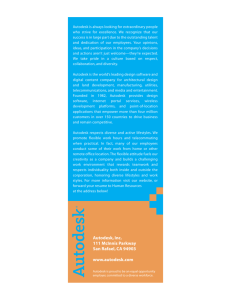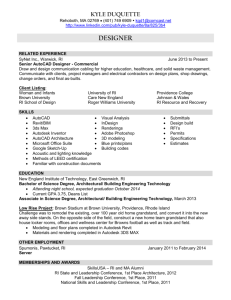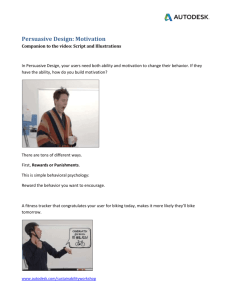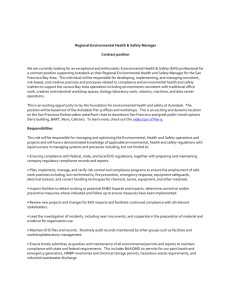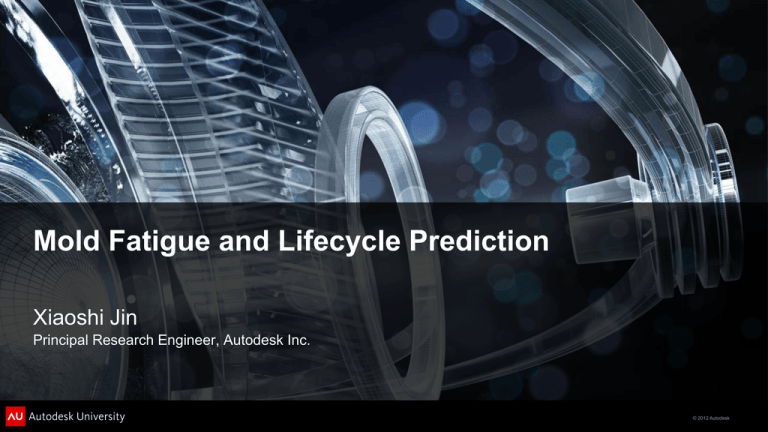
Mold Fatigue and Lifecycle Prediction
Xiaoshi Jin
Principal Research Engineer, Autodesk Inc.
© 2012 Autodesk
Class Summary
Conventional Mold designs in injection molding
Mostly
based on expert experience without a careful stress analysis
Mold set lifecycle relies largely on a rough estimate
Newly developed rapid heating cycle molding (RHCM)
Make
mold designs more challenge
How to achieve both higher productivity with low cost and better quality?
Review of Three Major Causes of Mold Damage
Thermal
Stress due to rapid heating and cooling
Mold deflection due to injection pressure imbalance
Clamping force induced stress inside mold blocks
Integrated Tool Developed:
Injection
molding simulation: Heat Transfer, Flow with Core-shift, Clamp Force
Mold STRESS and FATIGUE analyses
© 2012 Autodesk
Learning Objectives
At the end of this class, you will be able to:
Understand the nature of mold lifecycle: costs, quality and productivity
Understand the components of integrated analysis tool
Know how to set up the right mesh and boundary conditions
Interpret the results from Mold Fatigue Analysis
© 2012 Autodesk
Why Predict Mold Lifecycle?
© 2012 Autodesk
Market requests
Requests from far-east
RHCM in research and reality
Papers from Taiwan and China
Mold failures in Ford
Autodesk Moldflow Users’ Conferences back in 2010
NPE / ANTEC this year
Ford did its own “Mold Failure Prediction” with Moldflow and ABAQUS
Requests from other companies
© 2012 Autodesk
What we are in: CAE for Injection Molding
© 2012 Autodesk
What we face: Complexity of Mold Designs
© 2012 Autodesk
New Technologies drive the need
Rapid Temperature Cycling
®
(RTC )
/
Heat Mold for Filling
®
RHCM
/
®
Variotherm
ABS
Eliminate visible weld-lines
Increase flow length
High (uniform) gloss finish
Eliminate Gate Marks
(Cold slugs)
Typically only the cavity side is heated
Heat by: Steam,Water,
Electrical or Induction
Cool Mold during Packing
Reduce cycle time
Conformal Cooling
Conventional
Molding
With RTC
Images courtesy of Gas Injection World Wide
© 2012 Autodesk
New Technologies drive the need
Additive Manufacturing (AM) of Molds
Powder-based processes
Laser Engineered Net Shaping (LENS)
Selective Laser Sintering/Melting (SLS/SLM)
Direct Metal Laser Sintering (DMLS)
Three Dimensional Printing (3DP)
Rapid Prototyping of Mold
Low volume
Can we make it?
© 2012 Autodesk
What we face: Mold Damages, Fewer Shots
© 2012 Autodesk
Requirements for Mold Fatigue Prediction
If a mold is damaged earlier than its expected lifecycle
Mold maintenance service as a preventive care
Repair costs
Unexpected downtime
A backup mold set could be ordered
After certain cycles of molding which is based on failure statistics of different
molds in the past
New Technology may increase quality, increase productivity
But may not lower costs due to shorter mold lifecycle
A mold design/making should be based a careful
CAE analysis of the intended molding!
© 2012 Autodesk
What can we do with simulation tools?
© 2012 Autodesk
What available in Autodesk Simulation
Autodesk Simulation Moldflow Insight
RHCM Heat Transfer Analysis (Cool FEM)
Flow with Core-Shift
Clamping Force Prediction
Autodesk Simulation Mechanical
Linear Static Stress analysis (LSS)
Transient thermal stress analysis
Fatigue Wizard
Autodesk Simulation CFD
Application to Conformal Cooling in RHCM
© 2012 Autodesk
What are the major causes of Mold Damage?
Injection molding has a cyclic nature
Three cycles overlap together
• Mold Opening and Closing
• Heating up and Cooling down
• Injection pressure increases and decays
Heat Transfer induced thermal stress
Mold Deflection induced stress
It should be calculated with Heat Transfer Analysis in Cool (FEM)
Core-shift should be extended to Mold Blocks with LSS
Clamping induced stress
Use the prediction of clamping force with optional inputs
© 2012 Autodesk
Material properties for fatigue: Yield Strength, UTS
© 2012 Autodesk
Material properties for fatigue: S-N and E-N data
Stress-life log10 curve
Strain-life log10 curve
© 2012 Autodesk
Nature of Fatigue Data
© 2012 Autodesk
Nature of Fatigue: crack starts from surface
© 2012 Autodesk
Mold Fatigue Prediction Models
No mean correction
Stress-life methods
Gerber Correction
Goodman Correction
Walker Correction
Strain-life methods
Morrow Correction
Smith-Watson-Topper Correction
Walker Correction
Miner’s rule
Haigh Diagram
© 2012 Autodesk
Fatigue Wizard is a Generic Tool…, it can do
Multi-load Analysis
Static loads with user specified time history, all load cases need to be in the
same time span
© 2012 Autodesk
Fatigue Wizard is a Generic Tool…, it can do
Transient Analysis
Load cases over a time history
© 2012 Autodesk
Fatigue Wizard is a Generic Tool…, it can do
Spectrum Analysis
Load cases over a time history with specified load factors and repeated cycles
© 2012 Autodesk
Mold Fatigue Analysis is a Transient Analysis
Three sets of stress load categories are added up
Thermal Stress + Mold Deflection Stress + Clamping Stress at each point
Over the same time history
The data “input” are built automatically
Mold Fatigue Analysis needs a lot of data transfer
Temperature
overTime
ASME
Pressure
Stresses
Displacement
Cool
(FEM)
Flow (Mold
Deflection)
Fatigue
© 2012 Autodesk
Understand the nature of fatigue prediction
Accuracy of stress prediction plays a key role
A small percent of error in stress prediction can cause a big error in fatigue life
A pre-existed defect in a mold metal is hard to be modeled in a mesh
Stress prediction on surface
© 2012 Autodesk
How to setup Mold Fatigue analysis?
© 2012 Autodesk
Settings in Wizard
Include thermal stress in Cool (FEM) settings
© 2012 Autodesk
Settings in Wizard
Mold Fatigue Settings for all three load categories
© 2012 Autodesk
Mold Block Fatigue options
Mold Fatigue Options are based on mold pieces
© 2012 Autodesk
Fatigue properties
Fatigue properties are associated with mold piece
© 2012 Autodesk
Additional mechanical / strength properties
Additional mechanical / strength properties are needed,
Compression may not be the same as tension
© 2012 Autodesk
Mesh requirements: Mold Deflection vs. Stress
© 2012 Autodesk
Mesh requirements
© 2012 Autodesk
Mesh requirements (continue)
© 2012 Autodesk
Stress concentration around a hole
© 2012 Autodesk
False stress concentration due to poor mesh
© 2012 Autodesk
Better mesh around the holes
© 2012 Autodesk
Contact Conditions
© 2012 Autodesk
Boundary Conditions
© 2012 Autodesk
Boundary Conditions:
All fixed could be over-constrained
© 2012 Autodesk
How to interpret Mold Fatigue results?
© 2012 Autodesk
Mold Fatigue Analysis Results: Stress and Life
© 2012 Autodesk
If no damage is found…..
© 2012 Autodesk
Rapid Heating / Cooling induced thermal stress
© 2012 Autodesk
Mold deflection induced stress
© 2012 Autodesk
Clamping induced stress
© 2012 Autodesk
Mold deflection induced stress
© 2012 Autodesk
Clamping induced stress
© 2012 Autodesk
What if the mold metal has a lower S-N curve?
© 2012 Autodesk
What if a higher clamping force applied?
© 2012 Autodesk
Number of Cycles (shots) in log10 scale
© 2012 Autodesk
Approximated Range of Cycles, in log10 scale
© 2012 Autodesk
Discussions
Validation cases needed
Mold failure cases, where and when the failure happened
CAD model of mold and part
Process conditions
Clamping setup in the injection molding machine
Any suggestions are welcome
© 2012 Autodesk
Autodesk, AutoCAD* [*if/when mentioned in the pertinent material, followed by an alphabetical list of all other trademarks mentioned in the material] are registered trademarks or trademarks of Autodesk, Inc., and/or its subsidiaries and/or affiliates in the USA and/or other countries. All other brand names, product names, or trademarks belong to their respective holders. Autodesk reserves the right to alter product and
services offerings, and specifications and pricing at any time without notice, and is not responsible for typographical or graphical errors that may appear in this document. © 2012 Autodesk, Inc. All rights reserved.
© 2012 Autodesk

